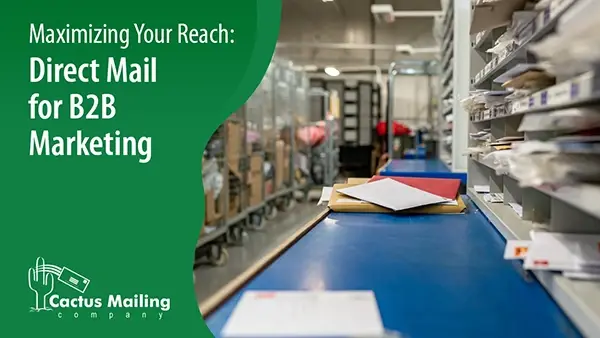We Are Here to Help!
What to Expect from Us:
No Pressure, Just Service!
Get no obligation pricing details and strategies that will work for your business.
Integrating marketing strategies in B2B marketing is necessary as it transcends the traditional approach of separate, isolated channels to create a cohesive and fluid experience for business clients across all platforms. In the intricate world of B2B marketing, synchronizing various marketing channels – from digital presence on websites and social media to traditional direct mail and email campaigns – can streamline the customer journey and reinforce brand consistency and trust for B2B marketers. Understanding and implementing an effective B2B marketing strategy is key for those looking to elevate their engagement tactics and build lasting business relationships. Join us as we unpack the essentials of integrating these strategies into your B2B marketing efforts, ensuring your brand resonates with your business audience and stands out in the competitive market.
B2B vs B2C Marketing
The distinction between Business-to-Business (B2B) and Business-to-Consumer (B2C) strategies is crucial. While both aim to drive sales, their paths diverge significantly due to the differing nature of their audiences. The core difference lies in the audience and their decision-making process. B2B buyers are focused on logic and return on investment, and B2B marketing often involves longer sales cycles and relationship building. On the other hand, emotions and convenience drive B2B consumers, and B2C marketing focuses on quick conversions and broad reach.

The Importance of a Cohesive B2B Strategy
A cohesive B2B strategy must be considered for a successful B2B brand. It is the foundation for building strong connections with your target audience, from the buyer persona to the individual consumer. The strategic approach involves the careful selection and execution of various tactic and marketing efforts by the B2B marketing team to achieve specific goals.
- Enhancing Customer Experience and Journey: Customer journeys are often complex and involve multiple decision-makers. At each stage, provide clear, informative, and relevant B2B content. Personalizing communication and ensuring that your solutions address your target businesses' specific needs and pain points can lead to a seamless and positive experience.
- Building Consistent Brand Messaging Across Various Platforms: Your brand's voice, values, and message should be uniform across all platforms, whether it's your website, social media channels, email campaigns, or print materials. Consistency helps reinforce your brand identity and makes your business more memorable to potential clients.
- Strengthening Customer Engagement and Relationship Building: B2B marketing thrives on long-term relationships and deep engagement. Supporting these aspects means moving beyond transactional interactions, fostering genuine connections through regular communication, understanding and responding to customer feedback, and proactively offering solutions and support. Engaging in meaningful ways with your clients demonstrates commitment and can increase loyalty, repeat business, and referrals.
Key Elements of a Successful B2B Strategy
A B2B strategy that is effective in driving sales and building lasting relationships with business clients requires several key elements. By focusing on these areas, businesses can create a comprehensive and dynamic B2B marketing strategy that resonates with their target audience and adapts to the changing market landscape.
Integration Marketing Channels
- Hybrid Marketing Model: Combining digital tools with traditional marketing channels is essential. This integration ensures a broader reach and more touchpoints with potential clients.
- Cohesive Omnichannel Presence: Ensuring a seamless experience across all channels, from social media to trade shows, strengthens brand consistency and enhances customer engagement.
Content Marketing
- Educational and Informative Material: Content in B2B marketing is more than just a sales pitch; it provides valuable information that helps potential clients make informed decisions. B2B content can include creating whitepapers, case studies, industry reports, and thought leadership articles.
- SEO-Optimized Content: Ensure your content ranks higher in search results or Google Ads by leveraging search engine optimization (SEO), increasing visibility to potential clients actively searching for solutions you offer.
Strategic Partnerships and Networking
- Collaborations for Mutual Benefit: Partnering with other businesses or industry influencers can open up new marketing and client acquisition channels. These partnerships can take various forms, such as co-hosting webinars, joint research projects, or co-authored content.
- Networking for Growth: Actively participating in industry events, online forums, and professional groups helps build a network that can provide referrals and insights into industry trends and customer needs.

Sales and Marketing Alignment
- Unified Messaging and Goals: Aligning sales and marketing teams in objectives and communication strategies leads to a coherent customer experience and more effective lead nurturing.
- Feedback Loop Between Teams: Establishing a regular feedback loop where sales provide insights from customer interactions to marketing can refine targeting and messaging strategies.
Personalization and Customer-Centric Tactics
- Customized Solutions: Tailoring marketing messages and solutions to meet the specific needs of each business client shows a deep understanding and commitment to their success.
- Engagement Strategies: Implementing strategies that focus on engaging customers at a personal level, such as through personalized emails or targeted content, builds stronger relationships.
Customer Feedback and Continuous Improvement
- Customer Surveys and Feedback Channels: Regularly collecting feedback through surveys, interviews, or feedback forms helps understand customer satisfaction and improvement areas.
- Data-Driven Adjustments: Using the feedback to make data-driven adjustments to products, services, and marketing strategies ensures that the business evolves in line with customer needs and expectations.
Integrate Your Marketing Strategy: Create a Seamless Customer Journey
Integrated marketing in the B2B landscape requires a strategic approach that aligns with the company's goals and the unique needs of its business customers. Here are key strategies for effectively integrating marketing efforts in a B2B context for more cohesive and impactful marketing.
Understanding Your Audience
Develop a comprehensive understanding of your customers by analyzing data from various touchpoints to reach and engage your target audience effectively. Utilize a Customer Relationship Management (CRM) system such as Salesforce or HubSpot to consolidate this data, creating a holistic customer view. For instance, if a customer engages in multiple ways — attending a webinar, emailing inquiries, visiting a trade show booth — record all these interactions in the CRM to form a detailed customer profile.
While B2B marketing caters to businesses, it's crucial to remember that the decision-makers are individuals. Personalization based on customer data and previous interactions can make the marketing efforts more effective and resonate more with the audience.
Tailoring Channel-Specific Strategies
Different channels serve distinct purposes in your marketing strategy. For example, while social media may excel in building brand awareness, email marketing can be more effective for lead nurturing. Adapt your engagement tactics accordingly, such as sharing thought leadership content on LinkedIn for industry expertise and sending personalized product updates through email based on previous customer interactions.
Cohesive Content Marketing
Ensure your marketing campaign content strategy aligns across all channels, from digital marketing to face-to-face interactions, maintaining tone, messaging, and visual branding consistency. For example, create a thematic campaign for a new product launch that spans blog posts, social media, email newsletters, and webinars. While keeping the core message uniform, tailor the presentation to fit each channel's unique format and audience.

Seamless Customer Service Experience
Understand how customers interact across different channels and at various stages of their buying journey with data analytics. These insights help in optimizing the customer experience and tailoring communications.
Aim for a smooth customer experience across all channels. A customer's journey from social media to your website or direct conversation with sales should be frictionless, with consistent messaging and service levels. For example, a query initiated on social media should easily transition to a phone call or email without the customer repeating information.
Implement CRM systems and marketing automation tools that facilitate the smooth transition of customer information across channels. This technology ensures that the customer experience is seamless, whether they are interacting online or offline.
Leveraging Technology for Effective Integration
Invest in marketing automation and analytics tools to synchronize activities across channels. Your technology stack should enable sharing information and insights across departments, enhancing collaboration and strategy execution. For example, use marketing automation to trigger personalized email sequences when a potential customer engages with your content, ensuring a consistent and relevant follow-up.
Continuous Optimization through Feedback
Establish feedback mechanisms to gather customer insights on their cross-channel experiences. Analyze this data regularly to identify improvement areas and optimize your strategy. Post-purchase surveys can provide valuable feedback on the buying experience, helping pinpoint and address any pain points in the customer journey.
Employee Engagement and Training
Ensure your teams, especially those in customer-facing roles, are well-versed in the omnichannel approach. Regular training sessions and a collaborative culture are essential. Employees should be proficient in using tools like CRM and marketing automation platforms to deliver a unified customer experience, enhancing the overall effectiveness of your integrated marketing strategy.
Select Your Marketing Channel for B2B Success
In business-to-business marketing, companies leverage various channels, each serving a unique purpose and requiring distinct strategies to succeed. Each channel allows the marketing team to improve market reach and enhance relationships with potential and existing B2B clients. Traditional marketing channels, such as trade shows and direct mail, offer tangible and personal engagement opportunities. In contrast, B2B digital marketing channels, including content marketing and social media, provide scalable and data-driven approaches. Let's explore these channels by highlighting their roles and how to optimize them effectively.
B2B Website
A B2B website should be more than a static page with contact information. It should be a dynamic hub that showcases your brand, products, and expertise. To optimize your B2B website, ensure it is user-friendly and responsive across all devices. Regularly update your site with informative blog posts, case studies, whitepapers, and other resources that address your target audience's pain points. Implement clear and compelling calls to action (CTAs) to guide visitors through your sales funnel.

Search Engine Optimization (SEO)
SEO is the heartbeat of your B2B online visibility. It's the art and science of getting your website to rank higher on search engine results pages (SERPs). An effective B2B SEO strategy starts with meticulous keyword research. Understand the terms and phrases your potential clients use to search for your products or services. Integrate these keywords naturally into your website's content, meta descriptions, and headings. High-quality backlinks from reputable websites are essential for boosting your site's authority in the eyes of search engines. B2B SEO is not a one-time effort but an ongoing process to ensure your website remains at the forefront of search engine results, driving organic traffic and conversions.
Content Marketing
Offer valuable information to address potential customers' problems or queries by creating diverse content, such as videos, infographics, and podcasts, and promoting this content across various platforms, including social media and email newsletters. According to Isoline, more than half of B2B buyers find video marketing to be of value. The key is to align your content marketing with industry trends and customer needs, ensuring it resonates with the target audience.
Read Content Marketing Institute's article about B2B content marketing trends.
Email Marketing
With its direct and personalized approach, email marketing nurtures leads through targeted communication. It's not just about sending business marketing emails but personalizing them based on the recipient's interests and interactions. The effectiveness of email campaigns can be amplified through A/B testing, which helps identify the most effective subject lines and call-to-actions.
Social Media Marketing
Social media marketing boosts brand visibility and fosters engagement. B2B companies must identify which social media platform their audiences frequent and focus their efforts there. Social listening becomes crucial here, as it helps understand audience needs and preferences, allowing for more targeted and effective engagement.
Google My Business (GMB)
B2B companies looking to enhance their online visibility in local searches must optimize their Google My Business listing. With GMB, businesses can create a detailed online profile that appears in Google search results and Google Maps. Your listing must have accurate and up-to-date information, including your address, service hours, and contact details. Encourage your customers to leave reviews and respond to them promptly to boost your online reputation further.
Pay-Per-Click (PPC) Advertising
Google PPC offers a fast track to enhanced visibility and website traffic. It's about targeting long-tail, less competitive keywords specific to the audience's needs and continuously refining campaigns for the best performance. Retargeting ads are also a vital part of this strategy, aiming to re-engage visitors who have previously shown interest.
Webinars and Online Workshops
Showcase a company's expertise and educate the audience through webinars and online workshops. Selecting current and interesting topics, promoting these events across marketing channels, and including interactive elements like Q&A sessions make these webinars more engaging and effective.
Direct Mail
Direct mail involves sending physical promotional materials, such as postcards, brochures, or catalogs, directly to a carefully targeted list of recipients. What sets direct mail apart is its tangibility – it engages the senses in a way digital channels can't. To optimize direct mail campaigns, B2B companies should craft compelling content that resonates with the recipients. High-quality materials and creative design can make the piece stand out while incorporating clear calls to action and response mechanisms (e.g., QR codes) to facilitate seamless interaction.

Trade Shows and Events
Trade shows and events provide a more traditional yet highly effective networking opportunity. The key here is to engage in robust pre-event promotion, actively interact with attendees during the event, and follow up with leads post-event. These events are excellent for building relationships and collecting valuable contact information.
Referral Programs
A referral program is a targeted marketing strategy to leverage connections and recommendations within B2B professional networks. A referral program encourages satisfied current clients to refer potential business partners or clients to the company. The program aims to capitalize on the trust and credibility inherent in B2B relationships by simplifying the referral process and providing relevant incentives. It focuses on transparency, tracking, and effective communication to foster a network of brand advocates who actively refer new business opportunities, thus contributing to the company's growth within the B2B sector. The key to the success of these programs is making the referral process easy and rewarding for clients through appropriate incentives.
Account Based Marketing (ABM)
Account Based Marketing (ABM) is a strategic approach in B2B marketing that focuses on identifying high-value target accounts, thoroughly understanding their needs, and delivering personalized and timely content and outreach to engage and convert these accounts. ABM blurs the lines between marketing and sales, promoting close collaboration between teams to nurture relationships, acquire new accounts, and retain existing ones. Leveraging technology tools like CRM systems and marketing automation is essential for tracking interactions and measuring success in ABM, making it a powerful strategy for forging lasting and meaningful connections with valuable clients.
Tip: Implement Omnichannel Marketing in B2B
Omnichannel marketing involves creating a seamless and consistent customer experience across various channels and platforms in the B2B market. An omnichannel marketing strategy recognizes that B2B decision-makers interact with a brand in numerous ways – through websites, social media, emails, in-person meetings, webinars, trade shows, traditional marketing, and more. By effectively blending various channels into a unified marketing strategy, a B2B business can ensure that they are meeting their customers wherever they are, both online and offline.
B2B Marketing Trends for the Future
B2B marketing is undergoing a significant transformation driven by technological advancements, changing buyer expectations, and a focus on sustainability and ethics. Staying agile and embracing these emerging trends will be crucial for B2B marketers to succeed. Here are some key trends that are shaping the future of B2B marketing:
- Artificial Intelligence (AI) and Machine Learning: AI and machine learning will continue revolutionizing B2B marketing. Marketers will leverage AI-powered B2B marketing tool for predictive analytics, lead scoring, chatbots, and content personalization. These technologies will improve efficiency and enhance the customer experience by delivering relevant and timely information.
- Voice Search Optimization: With the rise of voice-activated devices and virtual assistants, optimizing content for voice search will be essential. B2B marketers must adapt their SEO strategies to accommodate natural language queries and conversational searches.
- Sustainability and Social Responsibility: B2B buyers are placing greater emphasis on sustainability and ethical business practices. Companies committed to environmental and social responsibility will have a competitive edge. Marketing efforts will align with these values, showcasing eco-friendly products and corporate social responsibility initiatives.
- Influencer Marketing in B2B: While influencer marketing is usually associated with B2C, it is gaining traction in the B2B sector. Industry experts and thought leaders will collaborate with B2B brands to provide credibility, reach a wider audience, and establish trust within the niche market.
- Data Privacy and Compliance: With increasing scrutiny of data privacy and regulations like GDPR, B2B marketers will prioritize compliance and data protection. Transparency in data collection and usage will be essential to maintain customer trust.
- E-commerce Integration: B2B companies will increasingly integrate e-commerce solutions into their digital strategies. A B2B buyer expects the convenience of online purchasing, and B2B organizations will adapt to provide seamless and efficient transaction experiences.
- Customer Experience (CX) as a Competitive Advantage: Exceptional B2B customer experiences will be a key differentiator in the B2B space. Investing in tools and strategies to enhance CX, such as chatbots, self-service portals, and personalized support, will be a priority.
- Global Expansion: As markets become increasingly globalized, a B2B marketer must expand reach to international audiences. Localization of content and marketing strategies will be vital to connecting with diverse markets effectively.

Conclusion
A B2B company must embark on a strategic journey to create and achieve a successful marketing plan. Create a cohesive B2B marketing plan that harmonizes various channels in both traditional and digital marketing strategy. Tailoring communication to meet business clients' specific needs and pain points is essential. Staying relevant and competitive requires being vigilant on emerging trends.
Exceptional customer experiences are the holy grail of B2B marketing. More than providing a product or service is needed; it's about making the entire journey seamless and delightful. Navigating the complex terrain of B2B marketing is a journey that requires adaptability, innovation, and a deep understanding of the evolving needs of the B2B landscape.
Cactus Mailing is a reliable partner dedicated to supporting businesses in their mission to connect with customers through impactful and cost-efficient direct mail campaigns that supplement your B2B marketing strategy.
We offer a one-stop platform for businesses leveraging postcard marketing for outreach and engagement. We also offer postcard printing services for direct mail marketing. We provide a comprehensive solution for designing, printing, and mailing postcards tailored to specific business or organizational needs. Our service emphasizes high-quality printing and custom designs, allowing users to create visually appealing and effective postcards for their marketing campaigns. We also have a mailing list for various audiences and provide insights and resources on effective direct mail strategies.
Our postcards have helped various businesses get leads, boost brand awareness, and grow revenue. Let us help you create a marketing postcard design to achieve your goals!

 Cactus Mail Team: Apr 22, 2024
Cactus Mail Team: Apr 22, 2024




 Jill Brown
Jill Brown